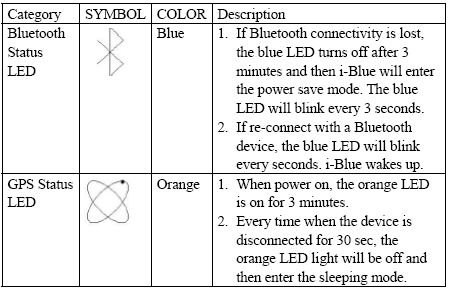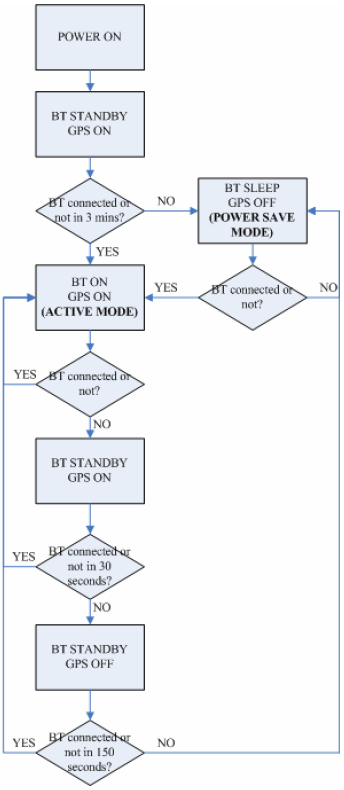i-Blue PS3200
4. The Tests
- Tests Day One
We tested the i-Blue PS3200 with a Dell Axim X50v. We recorded all produced data for a pre-selected route with VisualGPSce (free edition) and later analyzed it with GPSLog. We couldn't measure the TTFF tests ("Time to First Fix" which is the time it takes for a GPS to determine its current position), since GPSInfo "Cold Start" function doesn't work with NemeriX chipsets. All tests ran continuously, under the same environmental conditions (night, clear sky, 2.5° C ) and all installed in an Audi, model A4 2004.
| Globalsat BT-338 | i-Blue PS3200 | ||
| Time to First Fix (TTFF) | Secs | 38 sec | ? |
| Fix | Invalid | 0 | 0 |
| 2D | 0 | 12.5 | |
|
100 | 87.5 | |
| Satellites | Average (in view) | 8 | 8 |
| Average (in use) | 5.19 | 4.59 | |
| Average Signal Level (in dB) | Maximum per Satellite | 47.33 | 47.60 |
| Average per Satellite | 38.43 | 39.98 | |
The i-Blue PS3200 showed mixed behaviour. First of all, the device didn't have a 100% 3D fix. That means, it couldn't "easily" track all available satellites. It reached a maximum of 8 satellites (in view), however only used 4.59 (average). Looking at the Signal Levels, we saw that NemeriX chipset reached higher max/average per satellite figures compared to the BT-338.
- Tests Day Two (Pedestrian use)
We tested the device with a Dell Axim X50v. We recorded all produced data for a pre-selected route with VisualGPSce (free edition) and later analyzed it with GPSLog. All tests ran continuously, under the same environmental conditions (day time, clear sky, 20° C ). We carried the device with us, walking. For this test, we enabled the "Static Navigation" on the GlobalSat BT-338. There is no such function available on the i-Blue PS-3200.
| Globalsat BT-338 | i-Blue PS3200 | ||
| Fix | Invalid | 0 | 0 |
| 2D | 0 | 10.9 | |
|
100 | 89.1 | |
| Satellites | Average (in view) | 9 | 8.46 |
| Average (in use) | 7.07 | 5.52 | |
| Average Signal Level (in dB) | Maximum per Satellite | 43.50 | 43.60 |
| Average per Satellite | 35.53 | 37.40 | |
It seems, the PS3200 can be used for pedestrian use. Again, we saw better reception levels than the BT-338 with, however, higher TTFT times and loss of 3D fix.
- Tests Day Three (External Antenna)
We tested the device with a Dell Axim X50v. We recorded all produced data for a pre-selected route with VisualGPSce (free edition) and later analyzed it with GPSLog. All tests ran continuously, under the same environmental conditions (night, clear sky, 2.5° C) and all installed in an Audi, model A4 2004. This time, we had installed an external antenna to the i-Blue PS3200 to see if it would make any difference, compared with the antenna-less version.
| i-Blue PS3200 | i-Blue PS3200 +antenna | ||
| Fix | Invalid | 0 | 0 |
| 2D | 10.9 | 5.2 | |
|
89.1 | 94.8 | |
| Satellites | Average (in view) | 8.46 | 11 |
| Average (in use) | 5.52 | 5.72 | |
| Average Signal Level (in dB) | Maximum per Satellite | 43.60 | 47.86 |
| Average per Satellite | 37.40 | 38.91 | |
The external antenna did make a difference in the performance of the PS3200. The 3D fix times were lower, there were more satellites in view, and the Average Signal Levels (max/average) per satellite were better.
- Tests Day Four ( Indoor Sensitivity)
We placed both receivers inside a house, close to a big window and observed their performance. The Globalsat BT-338 had much quicker fix times (2D), almost 15 secs after power up, and even got a 3D fix after 1min of operation time. On the other hand, the i-Blue PS-3200, gave rather disappointing results since it didn't manage to find any satellites.
- Overall impressions
The i-Blue PS3200 performed well in most cases. Its most obvious weakness is that it doesn't offer a quick fix and most of the time, it looses its 3D fix, resulting in lower accuracy. On the other hand, the reception levels were very good, surpassing even the BT-338. Using an external antenna will further boost reception levels.
- Power Management Info
The PS-3200 is advertised as being capable of auto power on/off and being able to perform for up to 30 hours of continual operation or about 350 hours in sleep mode. If you make some quick calculations, using the device 2 hours per day and leaving it in sleep mode for the rest, it comes to around to a week of operation!

Before being able to use the internal power management functions, it is advised to pair the device (password four zero).When the device loses BT connectivity, it will turn itself off after 3mins (blue LED blinks every 3 secs). When the device finds BT near by (and assuming its has been paired with that device) it will turn itself on. If a BT device is found but is not paired, the i-Blue will not wake up, as is supposed to happen. The following diagram shows the logic behind the power management functions of the PS-3200.














